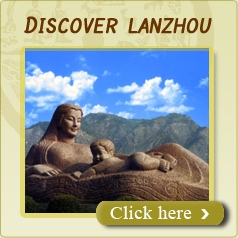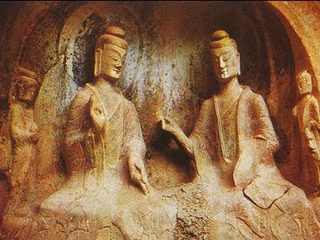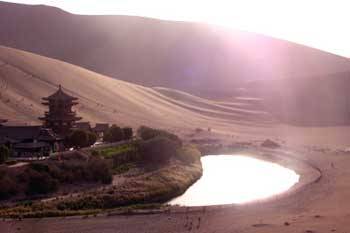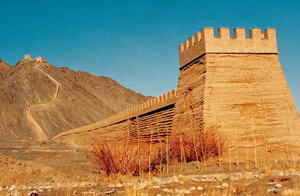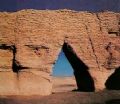Dunhuang Tourism
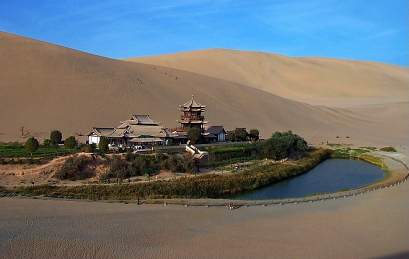
-
City Name:Dunhuang (Chinese: 敦煌, Pinyin:dunhuang)
-
Population :Municipality 310,100
-
Location :Located at 36°02′N 103°48′E
-
Overview:Dunhuang's greatest significance lies in its unique grottoes, located among a wilderness of yellow sands. Researchers say there are 735 grottoes in all, with the Mogao Grottoes providing a representative example.
Overview
Set on the edge of the Gobi desert, Dunhuang may seem like an unlikely place to find an oasis of Buddhist art. This is vast expanse of sky and Gobi desert, where the relics of ancient castles, the preserved section of Silk Road, the Han dynasty Great Wall, and merry songs on the grassland merge into one another.
The dust of the history has buried ancient civilizations. We can't imagine how many cultures of long histories under the thick yellow sand or soil. Going for a bumpy camel ride around the Grescent Moon Lake and Mingsha Sha, quietly going from cave to cave and seeing the exquisite artistry that the devout pilgrims of past instilled into barren site, are the chances to discover the lost civilizations. We can see strange languages and customs of minorities, religions distributed in the remote world, and smased feats of ancient emperors and kings.
Know more
Stories about Dunhuang
From the present day city it's hard to picture the importance of ancient Dunhuang. Once an important oasis town on the Silk Road, Dunhuang lies close to the border of Qinghai, Tibet and Xinjiang. In 111 B.C, under the Han dynasty, the Great Wall was extented here. Its strategic position meant that it was an important transit point for the spreading of Buddhism, which entered China during the 3rd century A.D. As Buddhism developed, so did the city. During the 4th century, Dunhuang was the last stop for Chinese Buddhist pilgrims on the road to India and the first stop for arriving missionaries.
In A.D 366, Le Zun, a Chinese monk on his way to India, had a divine vision of Buddha, which led him to believe he was on holy ground. In his fervor, he began carving out the first caves at the 1.6m long sandstone cliff face. Development continued through 10 dynasties and reached a peak during the Sui and Tang dynasties. Though the Sui dynasty lasted a short 38 years, emperor Wendi was a fervent Buddhist and during his reign 101 caves were carved, over twice as many as the previous 180 years.
It was during the Tang dynasty, China's golden age of economic prosperity and openness, when the caves were the most active. A community of monks, craftsmen and artists lived at the caves, getting their water from the mountain fed Daquan River that flows in front of the cliff. The highly international dynasty saw the introduction of Greek, Hindu and Central and Western Asian cultural influences. Of the over 1,000 Tang era caves, 232 have survived, about half the remaining 492 surviving caves. Most importantly, the Tang dynasty caves are considered the most artistically developed, such as beautiful murals of flying apsaras at the Mogao Grottoes.
Souvenirs
The best souvenirs in Dunhuang are the murals, paintings and calligraphy found at the caves. Dunhuang rugs are colorful and durable, and they make great gifts. For something truly unique, try a stuffied cloth camel.
Must see
Mogao Grottoes
25km to the southeast of Dunhuang is Mogao Grottoes, where the famed carvings are located. Of the 492 caves, 60 are open to visitors. About 45,000m2 of wall paintings and over 2,400 Buddhist sculptures have been preserved in this dry desert climate. The paintings themselves are a priceless resource documenting the changes in lifestyle, religion and culture over a thousand-year period. In 1987 the caves were added to the UNESCO list of World Heritage Sites.
Mingsha Sha
South of Dunhuang is Mingsha Sha, which means "singing sand mountain," though it's not really a mountain, but a giant sand dune. If you're looking for some excitement after the solemn caves, this is the place to be. The Buddhist pilgrims of old never had it this good.
Crescent Moon Lake
Surrounded by Mingsha Shan, the tiny Crescent Moon Lake shines like a diamond in the sand. It forms an oasis at the desert's edge. A peculiar natural phnomenon occurs when standing on top of the sand dune. If it's a windless day, a sound similar to a flute can be heard, but if there are many people descending the dune at once it becomes a thunderclap.
Jade Gate Pass
The Han dynasty Jade Gate Pass is 98km northwest of Dunhuang. Here was the ancient equivalent of the last gas station before a long stretch of road, the Silk Road to India that is. There's a preserved section of the SilK Road here.
Yang Pass
Yang Pass (Yangguan), also known as the Southern Pass, sits 75 kilometers southwest of Dunhuang, and was originally built by Emperor Wu in Han Dynasty as one of the two most important passes protecting Dunhuang from invasion from the west (the other pass is Yumen Pass).
